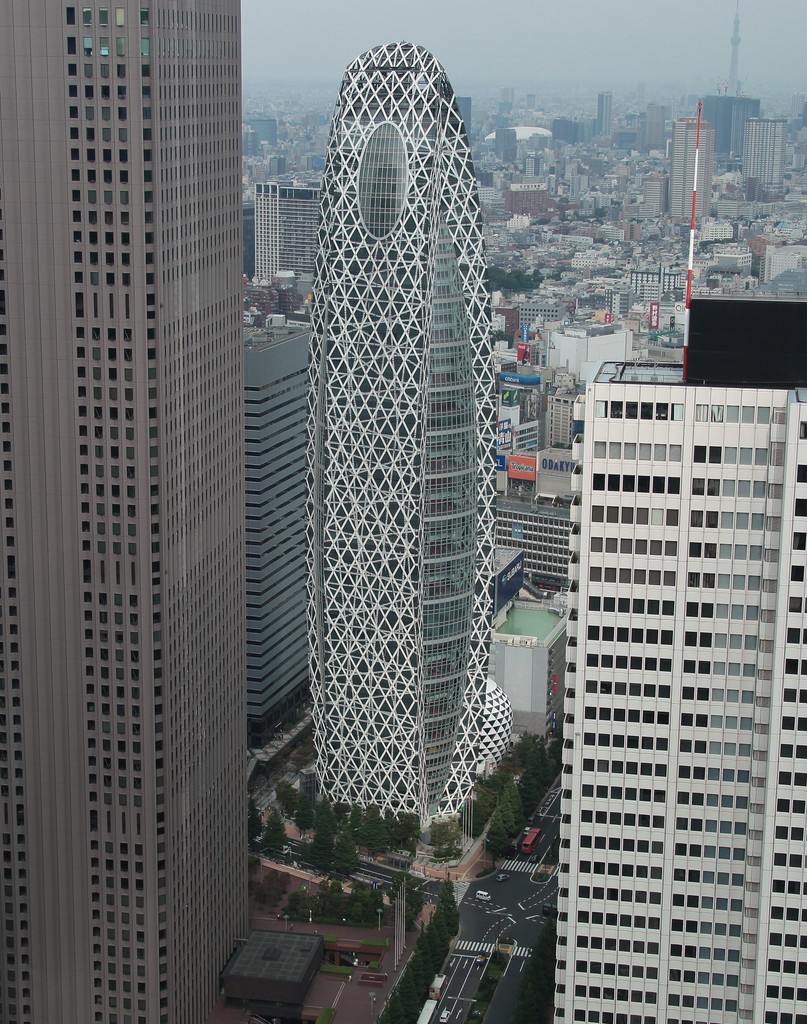MODE GAKUEN COCOON TOWER SHINJUKU TOKYO
La Mode Gakuen Cocoon Tower est un gratte-ciel ayant pour fonction une école de design et d'architecture.
Elle a une hauteur de 204 mètres et a été construite à Tokyo de 2006 à 2008 dans le quartier d'affaires Shinjuku à l'initiative de l'école de mode, Mode Gakuen. À l'issue de la compétition organisée c'est le cabinet d'architecture Tange Associates (créé par Kenzo Tange) qui est sélectionné pour construire un immeuble en forme de cocon symbolisant la protection accordée aux étudiants.
Elle a une hauteur de 204 mètres et a été construite à Tokyo de 2006 à 2008 dans le quartier d'affaires Shinjuku à l'initiative de l'école de mode, Mode Gakuen. À l'issue de la compétition organisée c'est le cabinet d'architecture Tange Associates (créé par Kenzo Tange) qui est sélectionné pour construire un immeuble en forme de cocon symbolisant la protection accordée aux étudiants.
L'immeuble est récompensé en février 2009 par l'Emporis Skyscraper Award, récompensant le gratte-ciel le plus remarquable de l'année 20081. Le design de la tour est en effet l'un des plus original du Japon ou se construisent depuis les années 2000 beaucoup de gratte-ciel sans grande recherche de style. La surface de plancher de la tour est de 80 900 m2.
----------------------------------------------
Mode Gakuen Cocoon Tower (モード学園コクーンタワー Mōdo gakuen kokūn tawā) is a 204-metre (669 ft), 50-story educational facility located in the Nishi-Shinjuku district in Shinjuku, Tokyo, Japan. The building is home to three educational institutions: Tokyo Mode Gakuen (fashion vocational school), HAL Tokyo (special technology and design college), and Shuto Ikō (medical college). Completed in October 2008, the tower is the second-tallest educational building in the world and is the 17th-tallest building in Tokyo.
Design
Before selecting a design for its new Tokyo location, Mode Gakuen held a competition asking architects to submit design proposals for the building. The only condition was that the building could not be rectangular. Mode Gakuen received more than 150 proposals by approximately 50 architects. The winning proposal was a cocoon-like structure designed by Tange Associates. According to Tange, the building's cocoon shape symbolizes a building that nurtures the students inside. White aluminum and dark blue glass exterior form the structure's curved shell, which is criss-crossed by a web of white diagonal lines earning it the name "Cocoon Tower". A Tange Associates spokesperson stated that their aim was to use the building to revitalize the surrounding area and to create a gateway between Shinjuku Station and the Shinjuku central business district. The building's design earned the firm the Emporis.com 2008 Skyscraper of the year award.
Facilities
Built on the former site of the now demolished Asahi Mutual Life Insurance Company headquarters, construction of the Mode Gakuen Cocoon Tower began in May 2006 and was completed in October 2008; The 204-metre-tall (669 ft), 50-story tower is the second-tallest educational building in the world (surpassed only by the main building of the Moscow State University) and is the 17th-tallest building in Tokyo. The vertical campus can accommodate 10,000 students for the three vocational schools that occupy the building. Tokyo Mode Gakuen, for which the building in named after, is a fashion school. The other schools, HAL Tokyo and Shuto Ikō, are information technology and medical schools, respectively, that are operated by Mode Gakuen University. Each floor of the tower contains three rectangular classrooms that surround an inner core. The inner core consists of an elevator, a staircase and a support shaft. Every three floors, a three-story student lounge is located between the classrooms and faces three directions: east, southwest and northwest.
----------------------------------------------
Mode Gakuen Cocoon Tower (モード学園コクーンタワー Mōdo gakuen kokūn tawā) is a 204-metre (669 ft), 50-story educational facility located in the Nishi-Shinjuku district in Shinjuku, Tokyo, Japan. The building is home to three educational institutions: Tokyo Mode Gakuen (fashion vocational school), HAL Tokyo (special technology and design college), and Shuto Ikō (medical college). Completed in October 2008, the tower is the second-tallest educational building in the world and is the 17th-tallest building in Tokyo.
Design
Before selecting a design for its new Tokyo location, Mode Gakuen held a competition asking architects to submit design proposals for the building. The only condition was that the building could not be rectangular. Mode Gakuen received more than 150 proposals by approximately 50 architects. The winning proposal was a cocoon-like structure designed by Tange Associates. According to Tange, the building's cocoon shape symbolizes a building that nurtures the students inside. White aluminum and dark blue glass exterior form the structure's curved shell, which is criss-crossed by a web of white diagonal lines earning it the name "Cocoon Tower". A Tange Associates spokesperson stated that their aim was to use the building to revitalize the surrounding area and to create a gateway between Shinjuku Station and the Shinjuku central business district. The building's design earned the firm the Emporis.com 2008 Skyscraper of the year award.
Facilities
Built on the former site of the now demolished Asahi Mutual Life Insurance Company headquarters, construction of the Mode Gakuen Cocoon Tower began in May 2006 and was completed in October 2008; The 204-metre-tall (669 ft), 50-story tower is the second-tallest educational building in the world (surpassed only by the main building of the Moscow State University) and is the 17th-tallest building in Tokyo. The vertical campus can accommodate 10,000 students for the three vocational schools that occupy the building. Tokyo Mode Gakuen, for which the building in named after, is a fashion school. The other schools, HAL Tokyo and Shuto Ikō, are information technology and medical schools, respectively, that are operated by Mode Gakuen University. Each floor of the tower contains three rectangular classrooms that surround an inner core. The inner core consists of an elevator, a staircase and a support shaft. Every three floors, a three-story student lounge is located between the classrooms and faces three directions: east, southwest and northwest.
